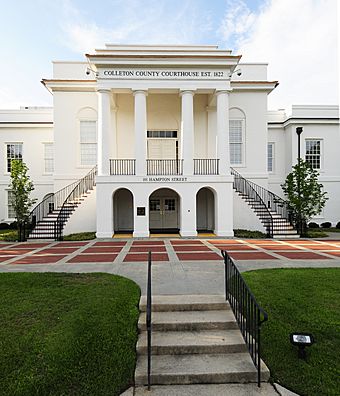Colleton County Courthouse facts for kids
Quick facts for kids |
|
|
Colleton County Courthouse
|
|

The front of the building
|
|
| Location | Corner of Hampton and Jeffries Sts., Walterboro, South Carolina |
|---|---|
| Built | 1820 |
| Architect | Robert Mills |
| Architectural style | Greek Revival architecture |
| NRHP reference No. | 71000765 |
| Added to NRHP | May 14, 1971 |
The Colleton County Courthouse is an important old building in Walterboro, South Carolina. It was built way back in 1820. This courthouse is special because it's a great example of Greek Revival architecture, which was a popular building style at the time. It's also famous for a big meeting that happened there in 1828 about states' rights. Because of its history and unique design, it was added to the National Register of Historic Places in 1971.
History of the Courthouse
In 1817, the town of Walterboro became the main center for Colleton County. This meant they needed a new courthouse. A famous architect named Robert Mills is believed to have designed the building. He designed many important buildings, including the Washington Monument. The courthouse was finished in 1820 by builders from Charleston.
In June 1828, a very important meeting took place inside the courthouse. It was about a big debate over states' rights, sometimes called "nullification." At this meeting, a person named Robert Rhett gave a speech. He asked the governor of South Carolina, John Taylor, to call a special meeting of the state's lawmakers right away. Another similar meeting about this topic was held at the courthouse in October of the same year.
What the Courthouse Looks Like
The Colleton County Courthouse is a two-story building made of brick. The main entrance is very grand, with a special porch called a portico. This portico has four large columns, which are like big pillars, and two staircases with fancy iron railings.
The main courtroom, where legal cases are heard, is located on the second floor of the building. The building also has a raised basement.
The courthouse looked a bit different when it was first built in 1820. In 1939, some changes were made. Two new sections, called wings, were added to the sides of the original building.
See also
 In Spanish: Colleton County Courthouse para niños
In Spanish: Colleton County Courthouse para niños



